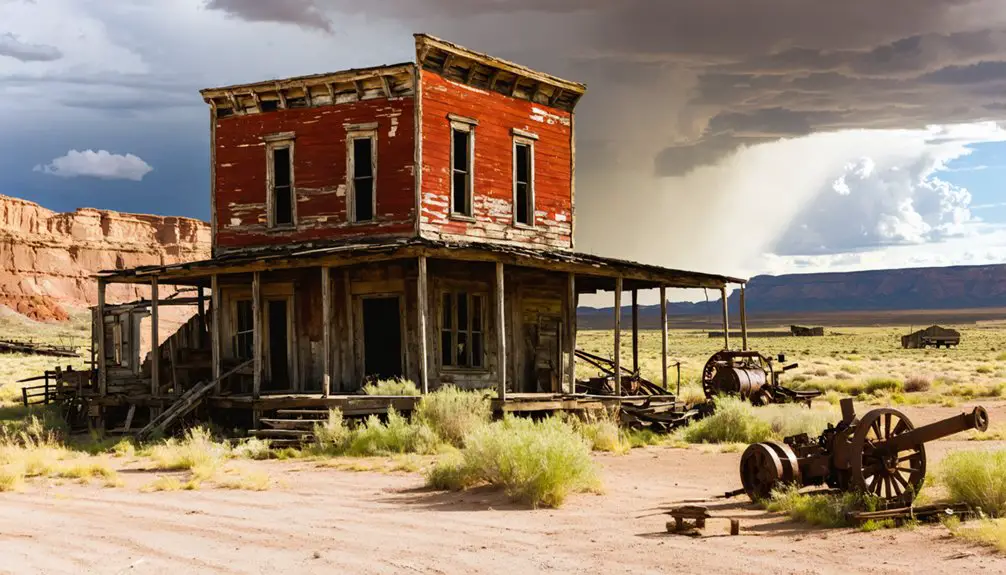Trinity sits abandoned in Washington’s Cascade Mountains, where ambitious copper mining dreams once flourished in the early 1900s. You’ll find it nestled near Phelps Ridge, where the Royal Development Company blasted an impressive 11,000-foot tunnel and built a thriving mountain community of 300 residents. By 1937, dwindling ore production and mounting costs forced the mine’s closure, leaving only scattered ruins and rusting artifacts. Nature has since reclaimed this remote outpost, but its engineering feats and immigrant stories still echo through the mountains.
Key Takeaways
- Trinity was a mining town in Washington’s Cascade Mountains established in the 1890s, primarily focused on copper extraction after failed gold ventures.
- The Royal Development Company built extensive infrastructure including an 11,000-foot tunnel through Phelps Ridge and a hydroelectric power plant.
- The community peaked at 300 residents, mostly Eastern European immigrants who worked in the mines and lived in harsh mountain conditions.
- Economic failure struck when copper mining proved unprofitable, leading to riots, sudden unemployment, and the town’s eventual abandonment.
- Nature reclaimed Trinity through heavy snowfall and vegetation growth, leaving only scattered ruins and rusting artifacts as evidence of its existence.
The Birth of a Mining Frontier
While prospectors had long sought riches in Washington’s Cascade Mountains, Trinity’s story began in earnest during the 1890s when ore deposits were discovered northeast of the future townsite.
Early mining efforts focused on gold and silver, but by 1900, copper emerged as the region’s most promising resource.
While miners initially chased gold and silver dreams, copper proved to be the true treasure hiding in Washington’s Cascades.
You’ll find that despite multiple failed ventures between 1892 and 1918, including the Chelan Mining Company’s unsuccessful attempts, the area’s potential remained untapped until a pivotal moment in 1918.
That’s when Catholic priest F.J. Naughten hired mining engineer P.J. Lonergan to reassess the claims.
This evaluation led Naughten to partner with his brother James, an experienced Butte miner, forming the Royal Development Company – a venture that would finally demonstrate the community’s resilience through successful copper mining operations. The company successfully raised four million dollars through stock sales to fund their ambitious mining operations.
The mine’s operations were significantly impacted by significant snowfall and avalanches during winter months, making year-round access to ore deposits challenging.
Copper Dreams and Mountain Schemes
You’ll find Trinity’s once-promising copper wealth buried deep within the Chiwawa district, where chalcopyrite ore beckoned early prospectors with dreams of fortune in 1892.
While other successful mines like those in Michigan achieved ore grade classification based on copper content levels, Trinity’s prospects remained uncertain. Royal Development Company’s ambitious plans included blasting an 11,000-foot tunnel through Phelps Ridge to overcome the brutal mountain winters that had hampered previous mining attempts.
Despite producing over 10,000 tons of copper ore by 1936, the operation’s insufficient ore grade and mounting costs would eventually force the company into receivership, leaving behind only silent reminders of broken mining dreams. By 1937, the mine’s output had dwindled to just 5,825 tons of ore.
Mining Wealth Gone Cold
Despite promising early discoveries of chalcopyrite deposits northeast of Trinity, the region’s copper mining dreams would ultimately turn cold.
You’d have found ambitious mining operations there, including an 11,000-foot tunnel and a flotation mill, all built to chase copper wealth through the harsh mountain terrain.
While the mine yielded 39,660 pounds of copper and 2,863 ounces of silver by 1935, these numbers couldn’t sustain the operation’s massive costs.
The reality of copper scarcity hit hard – by 1937, production had dropped to just 5,825 tons of ore.
Mining aspirations crumbled as operational expenses mounted, forcing the Royal Development Company into receivership.
The area’s Swakane Biotite Gneiss formations proved challenging for sustained mineral extraction.
Breaking Through Mountain Walls
After chalcopyrite deposits sparked mining interest in Trinity’s upper Chiwawa valley, ambitious engineers faced a challenging obstacle: conquering the harsh mountain terrain that threatened year-round operations.
You’ll find evidence of their mining innovation in the massive 11,000-foot tunnel they blasted through Phelps Ridge – a demonstration of mountain resilience and human determination.
The Royal Development Company didn’t stop there. They relocated operations to Trinity’s safer side, constructing a complete mining infrastructure including a sawmill, boarding house, and power plant.
To keep the drills turning, they harnessed the power of James and Phelps Creeks with hydroelectric projects.
Engineering Triumphs Against Nature
If you’d walked the narrow Phelps Creek valley in 1929, you’d have witnessed an extraordinary engineering feat: the blasting of an 11,000-foot tunnel through Phelps Ridge to overcome winter’s stranglehold on mining operations.
The tunnel’s construction transformed Trinity’s prospects by providing year-round access to ore deposits that had been previously cut off by heavy snows and devastating avalanches. Like Hanford’s early construction phase, the project required 40,000 tons of steel to reinforce the tunnel walls and support critical infrastructure.
Complementing this achievement, the company harnessed local waterways for power, establishing hydroelectric plants on James Creek and Phelps Creek that energized both the mining operations and the growing company town of 300 residents.
Moving Beyond Winter’s Grip
When winter’s icy grip threatened to strangle mining operations at Trinity, innovative engineering solutions emerged to keep the site running year-round.
You’ll find the true demonstration of winter resilience in the hydroelectric plants built on James and Phelps Creeks, providing stable power when snowstorms cut off fuel deliveries.
The engineers’ most daring feat was blasting an 11,000-foot tunnel through Phelps Ridge, bypassing treacherous avalanche slopes that had once halted work entirely.
They fortified buildings against crushing snow loads and positioned critical infrastructure to maximize natural shelter from the peaks.
While harsh conditions ultimately contributed to Trinity’s closure in the 1930s, you can still witness the ingenuity of these solutions today – the 1926 power plant continues serving the site, defying nearly a century of winter’s fury.
Today, a private caretaker maintains these historic structures, preserving the engineering legacy for future generations.
Tunnel Through Phelps Ridge
Through the solid rock of Phelps Ridge, miners carved an extraordinary 11,000-foot tunnel that revolutionized Trinity’s mining operations in the early 1900s.
You’ll find this remarkable feat of tunnel engineering stretched beneath the mountain’s core, connecting the avalanche-prone Phelps Creek valley to the safer Trinity side.
The Royal Development Company financed this ambitious project, bringing in crews to blast through the mountainside while carefully maintaining structural integrity.
They’d established hydroelectric plants on James and Phelps Creeks to power the mining infrastructure, enabling modern equipment to operate year-round. Like modern tunnel projects that use two boring machines to efficiently excavate through different ground conditions, Trinity’s engineers employed innovative methods for their time.
Despite the technical achievements in conquering nature’s obstacles, the tunnel’s promise couldn’t overcome the mine’s ultimate downfall.
Powering Mountain Mining Operations
Despite Trinity’s remote mountain location, innovative hydropower development transformed the mining camp into a marvel of industrial efficiency.
You’ll find that by 1928, engineers had harnessed nearby mountain streams to power a waterwheel and generator system, eliminating reliance on coal transport through treacherous terrain. This hydropower innovation drove the site’s groundbreaking flotation technology, installed in 1930, which separated valuable copper, gold, silver, and tungsten from raw ore.
The Royal Development Company maximized local resources, processing 20 million feet of timber through their sawmill to construct mining infrastructure. Situated at 3,199 feet elevation, the mining operation overcame significant challenges posed by the mountainous terrain.
When avalanche dangers threatened operations, they strategically relocated facilities across Phelps Ridge. By 1936, these engineering triumphs enabled the processing of over 10,000 tons of copper ore annually, proving that Trinity’s isolated location couldn’t stop industrial progress.
Life in an Isolated Mountain Community

As snowdrifts piled high around Trinity’s mining buildings in Washington’s remote Chiwawa Basin, residents faced the harsh realities of mountain isolation.
You’d find yourself hemmed in by 8,500-foot Buck Mountain and the narrow Phelps Creek valley, where avalanches and extreme weather tested your resilience daily. The isolation challenges shaped every aspect of life, from getting supplies to maintaining social connections among the 300-strong workforce.
Despite the obstacles, you’d witness remarkable community resilience as neighbors banded together to survive the unforgiving environment. Like the congregation at Trinity Evangelical Lutheran, residents found strength in their shared purpose and determination.
Your power came from ingenious hydroelectric projects on James and Phelps Creeks, while an 11,000-foot tunnel through Phelps Ridge provided critical mine access.
Yet beneath this adaptation to mountain life, tensions simmered – rumors of sabotage and distrust eventually contributed to the community’s decline.
The Immigrant Workers’ Experience
While Trinity’s mining operations drew workers from across America, Eastern European immigrants formed the backbone of its labor force, bringing their cultures and dreams of prosperity to this remote mountain outpost.
You’d find these immigrant struggles reflected in their daily lives – living paycheck-to-paycheck, enduring unstable seasonal work, and facing constant economic uncertainty.
Yet their cultural resilience shone through. They built tight-knit ethnic communities, establishing gathering places where their native languages and traditions flourished.
Within ethnic enclaves, immigrants preserved their heritage through shared spaces that kept cultural bonds and native customs alive.
When the Royal Development Company suddenly shuttered the mine, these workers’ fury erupted into protests. They’d spent their savings on mining supplies, only to face abrupt unemployment.
Despite this devastating setback, their shared identity as immigrant laborers strengthened their resolve, leading many to join broader union movements fighting for better conditions throughout Washington’s mining regions.
From Boom to Bust: The Final Days

Once Trinity’s mining companies failed to discover substantial gold and silver deposits, the town’s fate began to unravel.
While a 1918 copper discovery briefly revitalized hope, the economic impact proved devastating when this venture also failed.
You’d have witnessed the harsh reality of Trinity’s decline as frustrated workers, mostly Eastern European immigrants, faced sudden unemployment and riots erupted over perceived mismanagement.
The community dynamics shifted dramatically as families abandoned their homes in search of new opportunities.
Snow and avalanches, averaging 14 feet annually, accelerated the deterioration of unmaintained buildings.
Where over 300 workers once thrived, only scattered ruins remained.
The power plant stood silent, and rusting dump cars lay abandoned on narrow gauge rails – silent testimonies to Trinity’s final days as nature reclaimed the landscape.
Nature’s Reclamation of Trinity
The harsh mountain environment began its steady reclamation of Trinity after the last residents departed.
You’ll find nature’s relentless forces at work here – 14 feet of annual snowfall has crushed most buildings, while blackberry vines and cedars steadily consume what remains. The generator plant stands as one of the few surviving structures, though it’s slowly yielding to the elements.
Nature’s transformation has turned Trinity into a thriving wildlife corridor.
Where miners once extracted ore, you’ll now see ecological succession in action as native plants break down old concrete and tailings. The fenced-off townsite provides undisturbed habitat for local wildlife, while rusting ore carts and narrow gauge tracks slowly dissolve into the landscape.
It’s a reflection of the mountain’s power to reclaim what humans once built.
Surviving Structures and Artifacts

Scattered remnants of Trinity’s mining legacy still dot the mountainside, though decades of harsh weather have taken their toll.
You’ll find the generator building standing as evidence of the town’s survival strategies, while a few residences reveal their structural bones through fourteen feet of annual snowfall. The mine’s headframe stretches skyward, its skip car rails and intact ladder rungs defying time’s passage.
Historical preservation efforts face significant challenges, yet remarkable artifacts persist.
Rusting ore cars, narrow gauge rails, and a rare dynamite box offer glimpses into daily mining operations. The mess halls and commissary ruins tell stories of community life, while scattered mining tools and metal containers showcase early 20th-century industrial ingenuity.
Despite fire damage and structural collapse, these enduring pieces piece together Trinity’s rugged past.
A Monument to Mining Heritage
Beyond its physical remains, Trinity Mine endures as a tribute to early 20th-century mining innovation and community spirit in the Pacific Northwest.
You’ll find its cultural significance etched in the ambitious 11,000-foot tunnel through Phelps Ridge and the forward-thinking hydroelectric projects that powered both mine and town.
The site’s economic legacy tells a compelling story of boom-and-bust cycles, where a thriving community of 300 rose and fell with copper prices and production volumes.
Like countless mining towns before it, Trinity’s fortunes ebbed and flowed with the fickle tides of copper market prices.
As you explore Trinity’s history, you’ll discover how the mine’s innovative infrastructure – from its flotation mill to its complex rail systems – showcased American industrial ingenuity.
Today, the ghost town stands as a memorial to the determined miners who braved harsh conditions to build their dreams in Washington’s rugged wilderness.
Frequently Asked Questions
What Was the Average Salary of Miners Working in Trinity?
You’d have earned between $3-$6 daily at Trinity’s mining wages, depending on your skills and labor conditions, with skilled tunnel blasters making more during the mine’s peak operations from 1917-1937.
Were There Any Documented Deaths or Major Accidents in Trinity’s Mines?
While mine accidents and injuries were common at Trinity, you’ll find limited evidence of deaths except for the 1973 murder of a caretaker’s family. Mining safety records show frequent hazards but no confirmed fatalities.
Did Any Original Trinity Residents or Their Descendants Still Live Nearby?
With 14 feet of annual snowfall deterring resettlement, you won’t find any Trinity heritage preserved through local descendants today. Records show the last resident, Mr. Foster, served as watchman before passing away.
What Specific Mining Equipment and Technology Was Used in Trinity’s Operations?
You’d have found hydraulic mining equipment, steam-powered drills, ore crushers, and rail cars operating in the 11,000-foot tunnel system, alongside electrical switchgear and ore chutes feeding into haulage ways.
Were There Any Schools or Churches Established During Trinity’s Active Years?
You’ll find Trinity had an Episcopal boys’ school with military focus, established in 1857 in a converted house. While no standalone churches existed, religious institutions influenced the community through educational facilities.
References
- http://gonzopublicrelations.blogspot.com/2011/08/chiwawa-basin-day-1-trinity-mine.html
- https://trinityconservancy.org/history.html
- https://www.ghosttowns.com/states/wa/trinity.html
- https://www.treasurenet.com/threads/trinity-washington-ghost-town.39959/
- https://mb-henry.com/2023/11/01/ghost-town/
- https://archiveswest.orbiscascade.org/ark:80444/xv36261
- https://www.mindat.org/loc-15530.html
- https://en.wikipedia.org/wiki/Copper_mining_in_the_United_States
- https://apps.ecology.wa.gov/gsp/DocViewer.ashx?did=3254
- https://en.wikipedia.org/wiki/Hanford_Site



